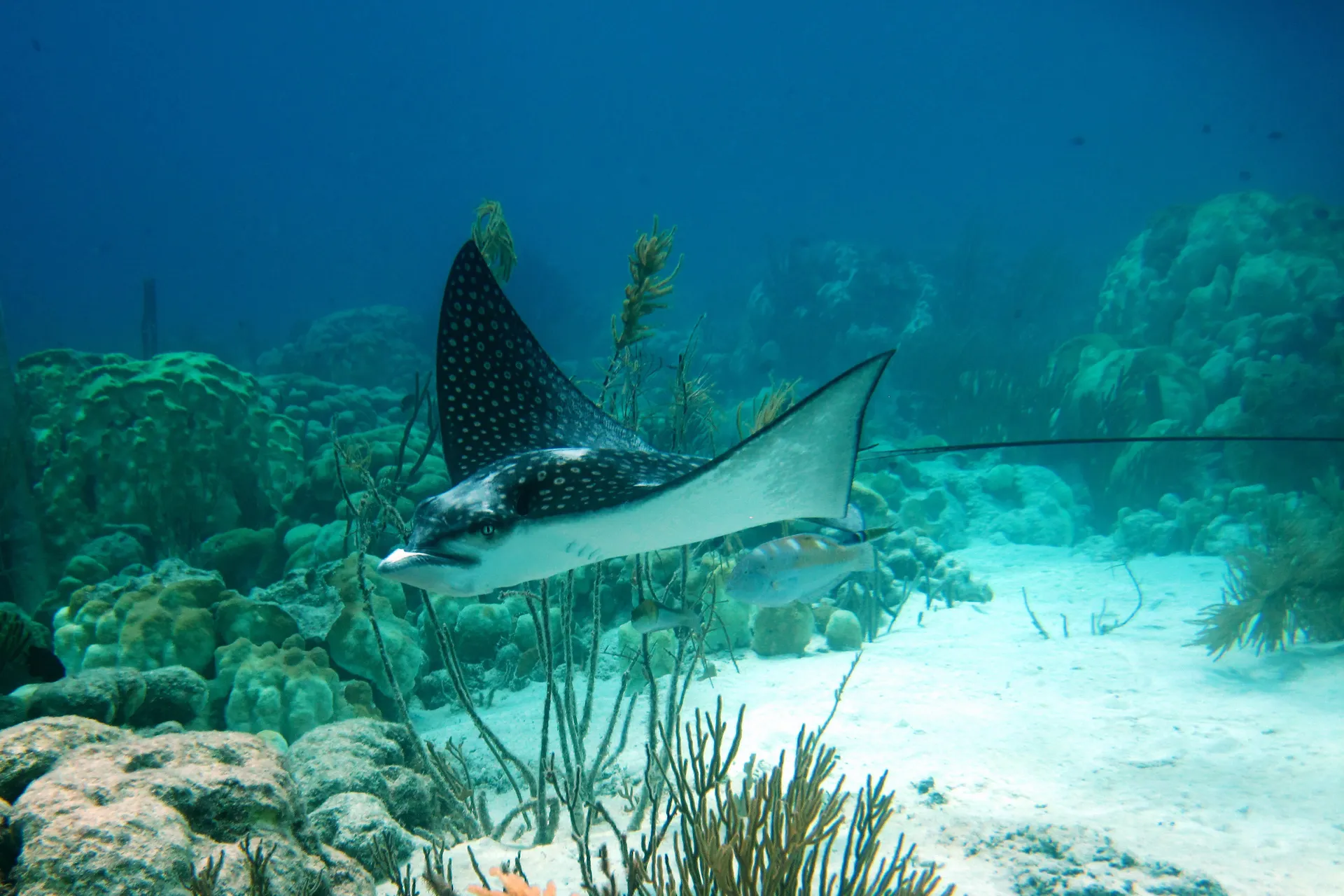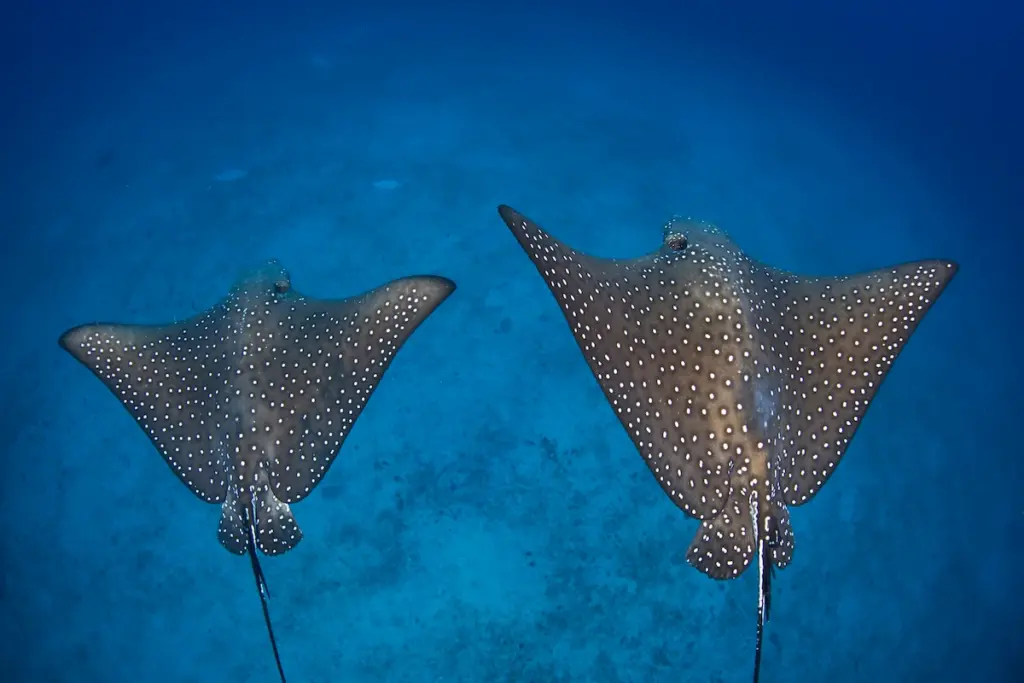All About Whitespotted Eagle Rays
Learn why a fever of rays is a beautiful sight to see

Just like a snowflake falling from the sky, the whitespotted eagle ray is unique; no two are exactly the same. The whitespotted eagle ray is a beautiful sight to behold with its long pointy tail and its body spotted with white dots.
The whitespotted eagle ray (Aetobatus narinari) is a cartilaginous fish—and one of the ocean’s largest rays. The genus name Aetobatus comes from the Greek word aetos meaning “eagle” and batis meaning “ray.”
Get Ocean Updates in Your Inbox
Sign up with your email and never miss an update.
Habitat and Size
Whitespotted eagle rays can be found swimming in tropical to warm temperate waters in the Atlantic. They are easy to spot because of their spotted bodies—and they are favorites for ocean photographers and scuba divers to witness.
The whitespotted eagle ray spends most of its time gliding through the open ocean. But they can also be found in coastal environments such as coral reefs, estuaries and bays. In the open ocean, whitespotted eagle rays usually swim in large schools towards the surface of the ocean. That would be a wonderful sight to see! They are also known to swim long distances.
Whitespotted eagle rays are massive in size—they have a wingspan of up to 10 feet and can weigh up to 500 pounds! If you were to measure one, from the tip of the snout to the tip of the tail, you would find that it could be as long as 16 feet. Female whitespotted eagle rays tend to be larger than the males.
Physical Appearance
When looking at a whitespotted eagle ray, you’ll notice that the snout looks similar to a bird’s beak—which is exactly how the whitespotted eagle ray got its name. Their unique-looking snouts work to their advantage. While looking for food, they use their snouts to investigate and dig around in the sand for something delicious to eat. Their mouths contain flat plates of teeth which are used to crush their food—the hard shells of crustaceans and mollusks.
Like a snowflake or human fingerprint, each whitespotted eagle ray has a unique pattern of spots. The top of the body is a darkish brown or black with white circles. The bottom of the body is whiteish.

Fun Facts About Whitespotted Eagle Rays
- A group of rays is called a “fever of rays.”
- In the animated Disney movie Finding Nemo, Nemo’s schoolteacher, Ray, is an eagle ray. Do you remember the song Ray sang to the students?
Venomous Tail Spines
The whitespotted eagle ray is shy and non-aggressive. However, it is still considered dangerous to humans because of its venomous tail spines which can cause some serious wounds. The whitespotted eagle rays use their tails, which may have two to six venomous spines at the base, for self-defense.
Flying and Jumping
Whitespotted eagle rays have occasionally been known to leap completely out of the water! Scientists don’t really know why they jump and leap. They think this unusual movement could be a mating ritual, an effort to escape predators, a way to communicate with other rays or a method to help remove parasites.
Diet and Reproduction
The whitespotted eagle ray, like other sharks and rays, has an electrosensory system consisting of hundreds of electroreceptive organs, referred to as the ampullae of Lorenzini. These organs help them sense other organisms hiding behind coral or buried in the sand. They are predators and use the ampullae of Lorenzini to detect prey and prepare for an attack. They enjoy eating mollusks, oysters, shrimp, crabs, octopus, worms, whelks and small fishes.
Regarding reproduction, whitespotted eagle rays are ovoviviparous. This means they reproduce via internal fertilization. The female incubates the eggs internally where they hatch. Then, the female gives birth to live pups.

Age and Population Status
The lifespan of a whitespotted eagle ray is about 15 years, but they can live to 20 years or more.
Whitespotted eagle rays are listed as “Endangered” on the Red List of Threatened Species of the International Union for the Conservation of Nature (IUCN). Their populations are declining throughout the world, with fishing being one of the main threats. They are directly targeted in some places around the world and caught as bycatch in other fisheries. They are also threatened by pollution, habitat loss and impacts from climate change.
How You Can Help Whitespotted Eagle Rays
It’s up to all of us to help protect whitespotted eagle rays, coral reefs, the open ocean and all the animals living in the sea. Ocean Conservancy is working with you to protect the ocean from today’s greatest global challenges. Together, we create evidence-based solutions for a healthy ocean and the wildlife and communities that depend on it.
Please make a donation to Ocean Conservancy—give today and make a difference for the future of our ocean!